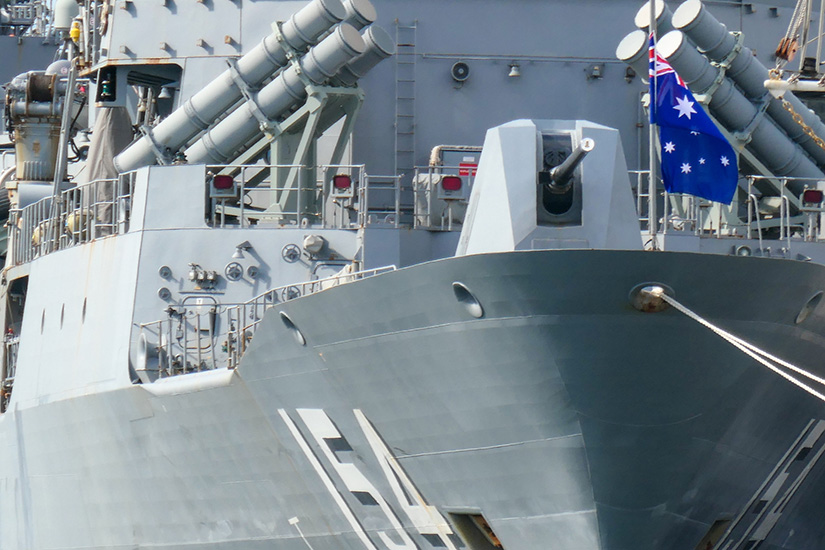Introduction:
April 24th saw the much-anticipated public release of Australia’s Defence Strategic Review (DSR) document. This sparked vociferous domestic debates in both the national media and among the strategic commentariat over its substance, quality, and implications. Now the dust has settled on such debates, it is worth taking stock of how the DSR will shape Australian defence policy going forward. This Analysis will provide a succinct appraisal of its content along with relevant critique on some key aspects, including drawing parallels with Japan’s own national strategic approach to the Indo-Pacific.
Back in August of 2022, the Labour Government of Prime Minister Anthony Albanese commissioned a five-member Team led by Stephen Smith (former Minister of Defence) and Angus Houston (former Chief of Defence Force), to prepare a thorough review of Australia’s strategic environment and defence force posture accompanied by policy recommendations for consideration. The aim of the review, according to current Minister of Defence and Deputy Prime Minister Richard Marles, was ‘to assess whether Australia had the necessary defence capability, posture and preparedness to best defend Australia and its interests in the strategic environment we now face[1].’ Following the 2020 Defence Strategic Update (DSU) released under the previous Coalition Government of Prime Minister Scott Morisson, the government advertised the DSR as ‘the most ambitious review of Defence’s posture and structure since the Second World War’[2].
Preceded by a National Defence Statement by Mr Marles, the DSR runs to 110 pages in length. The focus of its content is illustrated across its 14 Chapters. Rather than commenting on these 14 Chapters sequentially and in their entirety, this Analysis will outline essential substance of the DSR and comment on some of its more contentious aspects.

Challenge….
Like any exercise in strategic assessment, the DSR commences with an overview of the strategic circumstances and regional security environment to which the nation must respond (Chapters 1 & 2). As is now well-established, the DSR adopts the “Indo-Pacific” concept as its strategic framework for viewing “the region”[3]. The DSR’s portrayal of the regional security environment in the Indo-Pacific is remarkably similar to what is presented in Japan’s 2022 National Security Strategy (J-NSS), both of which identifies a security situation worse than ever experienced since the end of the Second World War[4]. It also echoes US 2022 National Security Strategy (US-NSS) emphasis on “strategic competition” as the defining element in Indo-Pacific (even global) politics. As Marles attests: “Australia’s region, the Indo-Pacific, faces increasing competition that operates on multiple levels – economic, military, strategic and diplomatic – all interwoven and all framed by an intense contest of values and narratives[5].“
As the power balance continues to shift with the rise of China, India, and other regional powers, Australia and its allies/partners are potentially losing their long-held strategic advantages. Australia is no longer as well insulated by its strategic geography and now finds itself proximate to the cockpit of great power competition in the Indo-Pacific. Moreover, “strategic risks” have emerged around a cluster of challenges involving military expansionism, disruptive technologies, coercive activities, nuclear proliferation and a heightened danger of strategic miscalculations around the region’s many “flashpoints” (e.g. the South and East China Seas, the Taiwan Strait and the Korean Peninsula)[6]. Though Mr Marles’ National Defence Statement expresses the Australian government’s desire for a stable relationship with Beijing, Chinese assertive and destabilising actions are identified explicitly as issues of national concern within the context of Sino-American strategic rivalry.
…and Response
A Holistic Approach to Defence:
The remaining 12 Chapters (3-14) successively layer the ways and means through which Australia will shape its defence strategy in response to this challenging security environment. The first thing to note is the adoption of a holistic approach to the full spectrum of challenges that strategic competition presents. This is framed as “whole of government” and “whole of nation” effort that leverages “all elements of national power” – again this echoes Japan’s determination to exercise its “comprehensive national power” in its own national strategy[7]. Indeed, though the DSR is primarily directed towards defence strategy and defence/force posture, it contains many (welcome) intimations towards a broader “national security strategy”, for example the declaration that ‘Statecraft must be driven and directed by a clear sense of national strategy and be coordinated across government through a clear and holistic national strategic approach[8].’ Though much of the DSR speaks to questions of national strategic policy, given its remit, these are not extrapolated in full[9]. Significantly, one of its most important recommendations (accepted by Government) is the future release of a biennial National Defence Strategy document, replicating those of the US and Japan (but not a “National Security Strategy”).
A Defence Strategy of “Denial”
Instead, its primary directive is to map out a credible new strategy for defence by redefining Australia’s defence posture and force structure. In this respect it advocates for a conceptual shift away from the past five decades of the “Defence of Australia”[10]. Its place will be taken by “National Defence” concept, characterised by a more holistic approach that aims at maintaining the regional balance of power, alongside allies and partners[11]. At the core of this approach is the strategy of “deterrence through denial” to make Australia a “hard target” for any potential aggressor through a combination of building up a forward-leaning defence posture in the north), backed by a highly resilient national infrastructure that capitalises on Australia’s enviable “strategic depth”.
To effect this Australia will need to be able to position and operate Anti-Access/Area Denial (A2/AD) capabilities that bar its northern approaches to an aggressor, holding intruding assets at risk in the designated theatre of operations and across all warfighting domains (land, sea, air, space, cyber). In the event of an enemy attack or attempt at offshore coercion Australia should be able to rely on a resilient defence network, including hardened and dispersed facilities, sufficient fuel and munitions stocks, and adequate logistics. Behind this Australia must be politically, economically, and environmentally secure. On this basis, Australia will also do its part in contributing to the broader alliance deterrent front as part of “integrated deterrence” – an American concept covering a full spectrum of diplomatic, technological, military dimensions working in synergy with allies[12].
Achieving the goal of a credible “deterrence by denial” has major follow-through implications for the force posture of the Australian Defence Force (ADF). The DSR argues for a transition away from a “Balanced Force” – basically retaining a mix of everything to respond to a variety of contingencies – to a more focused and “Integrated Force”, designed to harness ‘effects across all five domains: maritime, land, air, space and cyber’[13]. Here again are strong echoes of Japan’s determination to forge a “Multi-Domain Defense Force”[14]. The Integrated Force will strengthen Australia’s northern bases, improve the Royal Australian Navy’s (RAN) underwater and Intelligence Surveillance and Reconnaissance (ISR) capabilities, augment long-range strike in all domains, emphasise amphibious operations, and be fully “networked” under a theatre-command with the necessary Command, Control, Communications, Computers and Intelligence (C4I) infrastructure.
A Recalibrated Force Structure:
To ultimately realise the necessary Integrated Force, some significant changes in the force posture and capabilities of the ADF are envisaged. Most controversially, the Army would be restructured to optimise its capacity for littoral operations in the vital northern defence zone. The DSR recommends significant improvements in long-range strike capability including the acquisition of the High Mobility Artillery Rocket System (HIMARS). These missiles however are confined to theatre operations with a range of only 300km, thus regrettably circumscribing the “reach” of Australian denial capabilities. In order to expedite these new acquisitions, the DSR recommended (and government accepted) significant cuts in new Infantry Fighting Vehicle (IFV) procurement (reduced from 450 to 129) and the abandonment of plans to equip a second Artillery Regiment with self-propelled howitzers. This caused some consternation both in the Army itself, and among prolific strategic analysts. Strategic Analysis Australia’s Peter Jennings argues that ‘A decision to remove a core army capability without a meaningful replacement critically weakens the ADF’[15].
If the Army was perceived to be the “loser” in the DSR exercise, the RAN comes out a clear “winner” in terms of the resources and role it will acquire. The RAN will be expected to play a major part in the denial strategy, with the procurement of a flotilla of nuclear-powered submarines under the AUKUS agreement[16]. One surprise in the DSR was the absence of any recommendation as to where the primary nuclear submarine base would be located – an issue that has generated domestic controversy as all the proposed sites have expressed reluctance to accept such a base (at present Port Kembla, NSW, is the favoured option). The DSR also recommended that the RAN’s surface fleet requirements be subject to a review[17][18].

The Royal Australian Air Force (RAAF) will also be afforded additional striking power through the arming of F/A-18 and F35s with long range missiles, and acquisition of MQ-28A Ghost Bat Unmanned Aerial Vehicle (UAV), to be developed with the US. Again, the DSR’s explicit rejection of acquiring the B-21 Raider long range bomber invited controversy among strategic commentators[19]. With only around 100 fast jets with limited range and endurance and relatively short-range missiles, any deterrent capability will only come into (too) close to the shores of Australia[20]. For the Space and Cyber domains the DSR contented itself with favouring a general enhancement of capabilities. A dedicated “Space Force” was ruled out and the acquisition of the REDSPICE offensive cyber system endorsed[21]. Given that the DSR identifies that we are living in “the missile age” the recommendation to urgently develop a layered integrated air and missile defence (IAMD) is significant. To facilitate the denial strategy ‘This must comprise a suite of appropriate command and control systems, sensors, air defence aircraft and surface (land and maritime) based missile defences[22].’ If all the preceding recommendations (accepted) are implemented efficaciously, initial enhancements will lead to the Objective Integrated Force by 2026-30, with the delivery of the Future Integrated Force to be realised by 2031 onwards.
Building The Necessary Defence-Industrial-Technological Base:
These ambitious plans for force restructuring are predicated upon an overhaul of the nation’s defence-industrial base and support networks. In addition to the colossal injection that AUKUS will (eventually) provide to Australia’s naval-building capacity, the DSR takes up the long-held view that the only way to sustain a sovereign defence-industrial capacity is the guarantee a continuous build-cycle in domestic naval yards. But while major platforms such as the AUKUS-submarine project and Hunter Frigates can often steal the limelight, the DSR ensures that significant attention will be afforded to game-changing technologies as part of the broader techno-strategic competition underway. It affirms that ‘Technology has a significant impact on the character of warfare and deterrence and will shape the changing balance of power’[23]. Some of the ambitious technological projects incorporated into Pillar II of AUKUS, such as hypersonics, AI and Quantum computing, will need serious investments in R & D through the Defence Science and Technology Group and the new Advanced Strategic Capabilities Accelerator.
The augmented defence posture will also need to be resourced through more mundane actions such as workforce training and recruitment and retention, provision of adequate stock of munitions, fuel supply, and simple base infrastructure/logistics upgrades. The Guided Weapons and Explosive Ordnance Enterprise (GWEO) is a key element of this, with the mandate ‘to increase and improve the supply surety, availability and reliability of the ADF’s [munitions] inventory’[24]. An enhanced sovereign defence-technological base therefore supplements heavy industry and is crucial to acquiring the “asymmetric” military advantages that the deterrence by denial strategy depends upon. Crucially, all of this must be adequately funded, and all industrial/technological procurement projects managed with improved fiscal responsibility. It flatly recommends that ‘Defence funding should be increased to meet our strategic circumstances’[25]. So far this has not occurred, with spending currently running at about 2% of GDP, with analysts calling for a necessary increase to 3%[26].
Climate Change:
Finally, the DSR is notable for its priority on climate change (Chapter 5). Perhaps with a view to the current Labor Government’s sensibilities as much as the environment serving as a (non-traditional security) threat-vector, the DSR contains a large section on how defence needs to adjust to the challenges that climate change presents. Climate change policies are well-known and frequently showcased on the international stage, however in light of the severe typhoons that have severely impacted US military activities in Guam recently, extreme weather systems have to be factored into the defence operating context[27]. On this point, the DSR contends that ‘Climate events already place concurrency pressures on the ADF and this has negatively affected force preparedness, readiness and combat effectiveness[28].’ It argues that domestic natural disasters such as recurrent severe flooding in parts of Australia has drawn off ADF resources away from their primary warfighting mission, with detrimental effects on training and preparedness.

Conclusions
While the original version is classified (only defence insiders know exactly what the original contains and what Smith and Houston themselves actually recommended), the publicly released version of the DSR is a highly significant strategic document in that it provides a “return to first principles” assessment of what challenges Australia faces and recommends a comprehensive and sometimes radical set of responses, practically all of which have been adopted as official government policy. It does not hold back on advocating relatively controversial changes to defence and force structure that have caused dismay and opposition in some quarters of the domestic establishment.
The chief criticisms of the DSR have focussed upon the very “modest” ambition in increasing strike capabilities to support the deterrence by denial strategy (not enough quantity, and not sufficiently long-range missiles), its detrimental effect on the army’s armoured capability, and its lack of guaranteed fiscal resourcing. Given the DSR’s urgent exhortation to increase readiness and accelerate defence acquisitions to make the ADF “fit for purpose” when strategic “warning time” of conflict is reduced, it is perplexing that its recommendations were not even more robust and definitive – why wait to review the surface fleet, why not buy more longer-range missiles sooner, and why attach such long-term time frames for the development of the Future Integrated Force? Yet, anyone familiar with the complex and sometimes inefficient wheels of defence bureaucracy in Australia will quickly realise the limitations and obstacles that will need be patiently overcome to realise the DSR’s recommended outcomes.
Much of its content, both in terms of its strategic appraisal of the Indo-Pacific security environment, and the measures to be taken in response, closely comports with strategic approaches adopted by Australia’s closest partners – the US, Japan, and the UK. Indeed, the DSR shows strong evidence of having emulated the best-practice of these close affiliates, and this will assist the country in coordinating with them. As an archetypical “middle power” Australia does not have the resources or capabilities to independently affect the regional balance of power and must rely on its US alliance and highly-developed Strategic Partnerships with Japan, the UK, and others to play its part in a united front to withstand strategic competition[29]. The DSR provides a clear road map of how Australia intends to achieve its desired objectives in tandem with its trusted allies and partners.
(2023/06/19)
Notes
- 1 Australian Government, National Defence: Defence Strategic Review, (DSR), Commonwealth of Australia 2023, p. 5.
- 2 Australian Government, Department of Defence, 2020 Defence Strategic Update, Commonwealth of Australia 2020, Ibid.
- 3 Rory Medcalf, Indo-Pacific Empire: China, America and The Contest For The World's Pivotal Region. Manchester University Press, 2020.
- 4 Government of Japan, National Security Strategy of Japan 2022, Tokyo, p. 2.
- 5 DSR, p. 5.
- 6 Thomas Wilkins, ‘Australia and Japan Facing “Disruptive” Challenges To The Rules Based Order In The Indo-Pacific’, Policy Brief, Japan Institute for International Affairs (JIIA), 26 September 2018.
- 7 National Security Strategy of Japan 2022 p. 3.
- 8 DSR, p. 34.
- 9 For a broader appreciation of Australian aims and objectives in foreign and security policy, one will need to refer to the (outdated) 2017 Foreign Policy White Paper: Department of Foreign Affairs and Trade (DFAT), 2017 Foreign Policy White Paper, Commonwealth of Australia, 2017.
- 10 As enshrined in the 1987 Defence White Paper, it was aimed at deterring and responding to low-level threats from a small or medium power.
- 11 DSR, p. 18.
- 12 Jane Hardy, ‘Integrated Deterrence in The Indo-Pacific: Advancing The Australia-United States Alliance’, Analysis, US Studies Centre, Sydney, 15 October 2021.
- 13 DSR, p. 19.
- 14 Ministry of Defense, ‘National Defense Strategy’ Tokyo, 16 December 2022.
- 15 Peter Jennings, ‘Frankenstein-style Defence Review fails on Credibility’, The Weekend Australian, 29-30 April 2023.
- 16 Australian Government, Defence, ‘AUKUS Nuclear-Powered Submarine Pathway’, Commonwealth of Australia, 2023.
- 17 David Shackleton, ‘The Hunter Frigate: An Assessment’, Strategy Report, Australian Strategic Policy Institute, April 2022.
- 18 Perhaps with an eye to answering critique over the procurement of (Type-26) Hunter Frigates from the UK, which many have deemed, in their present design configuration, to lack sufficient striking power.
- 19 Andrew Tillett, ‘Buy 12 stealth bombers at $28b to counter China: ASPI’, The Australian Financial Review, 12 December 2022, Peter Jennings, ‘Frankenstein-style Defence Review fails on Credibility’, The Weekend Australian, 29-30 April 2023.
- 20 Greg Sheridan, ‘Sleepwalking to Tragedy’, The Weekend Australian 29-30 April 2023.
- 21 Ben Scott, ‘Australian Cyber: What’s “Redspice” for?’ The Interpreter, Lowy Institute, 14 April 2022.
- 22 DSR, p. 69.
- 23 DSR, p. 76.
- 24 Australian Government, Defence, ‘Guided Weapons and Explosive Ordnance Enterprise’, Commonwealth of Australia, (no date).
- 25 DSR, p. 96.
- 26 Peter Jennings, ‘Frankenstein-style Defence Review fails on Credibility’, The Weekend Australian, 29-30 April 2023.
- 27 Eric Roston, ‘Guam typhoon highlights climate threat to U.S. military in Pacific’, The Japan Times, 25 May 2023.
- 28 DSR, p. 41.
- 29 John Lee, ‘Asian Allies can keep China at Bay if We Work Together’, The Weekend Australian, 6-7 May.

